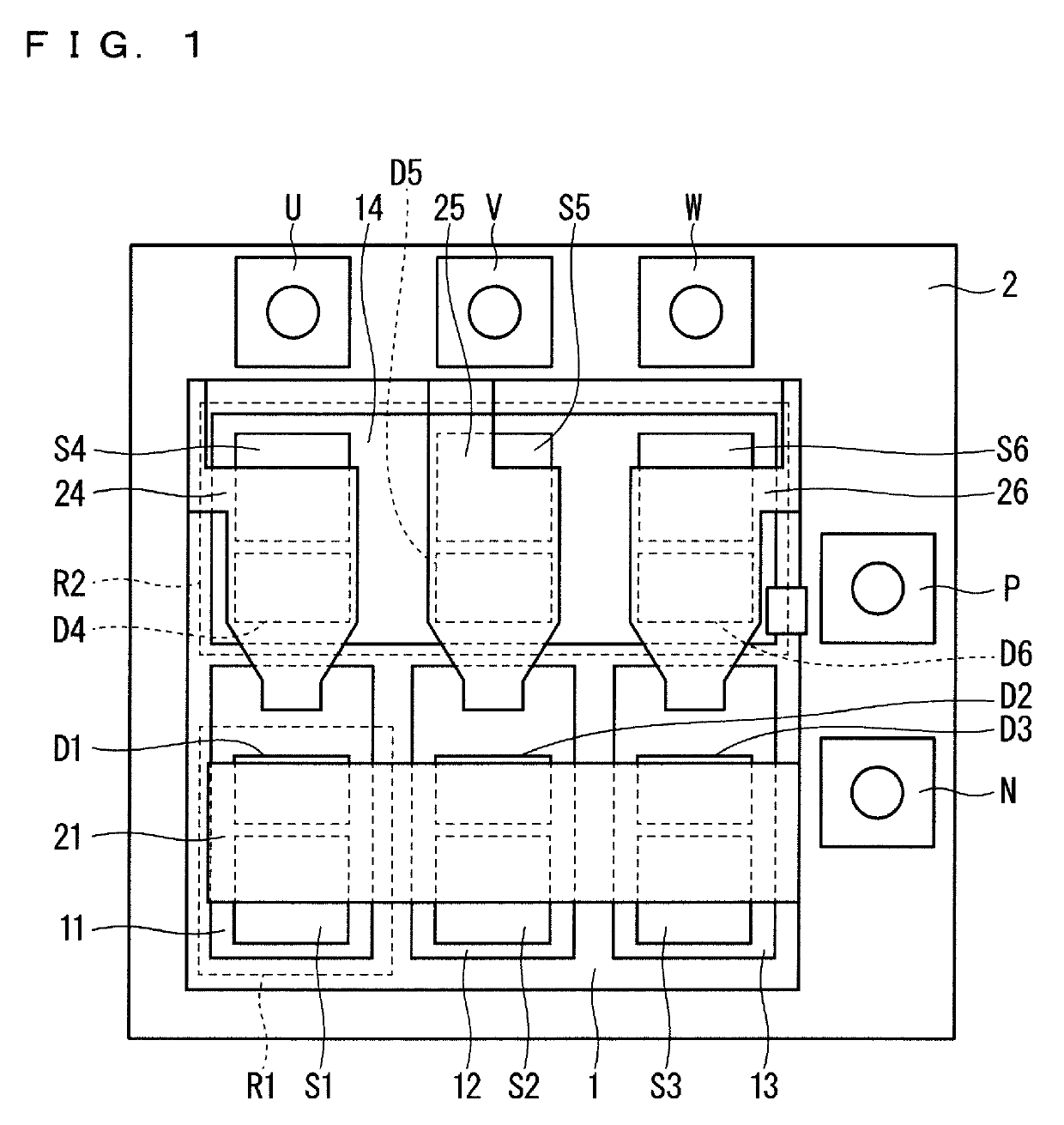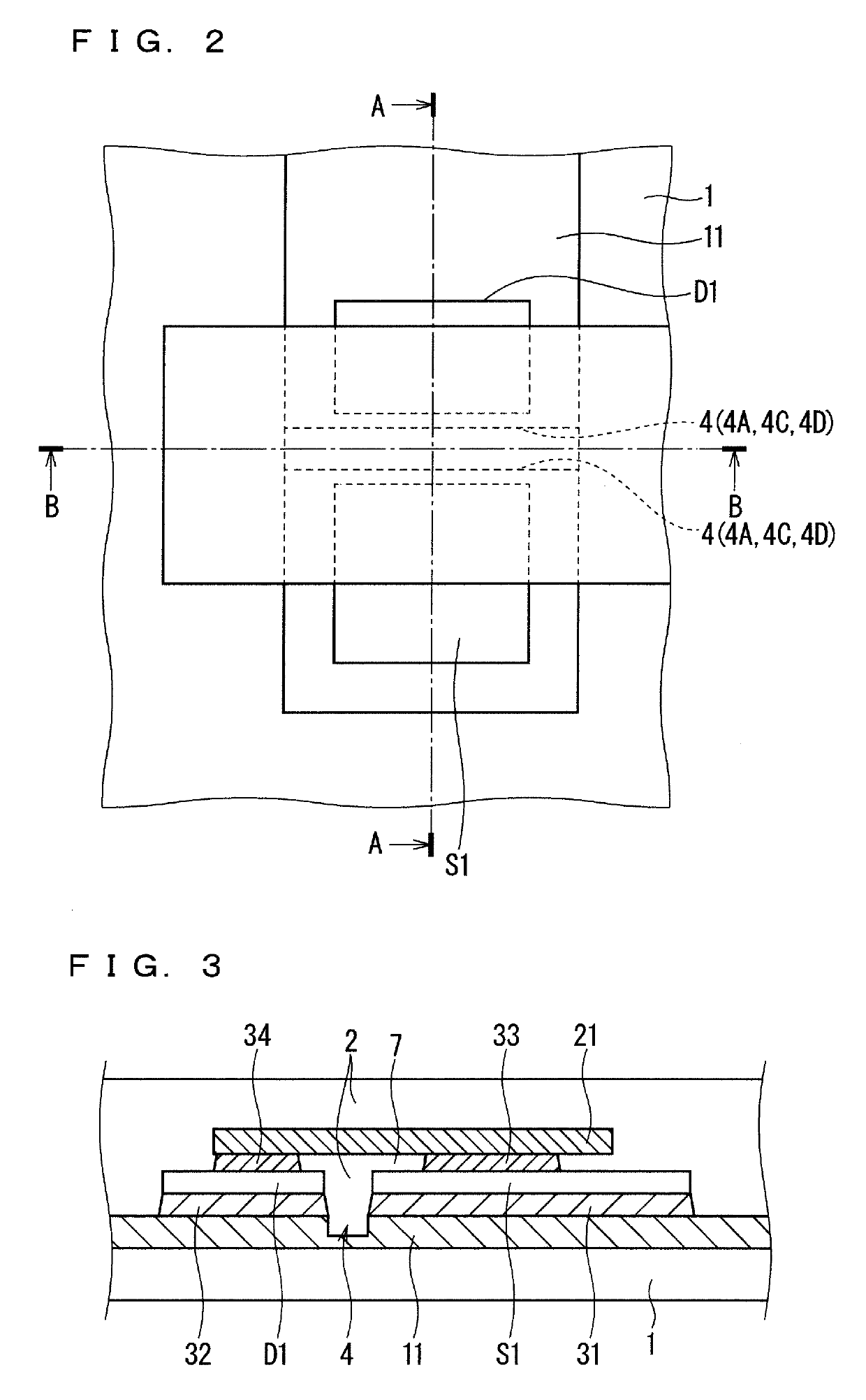Semiconductor device and power converter
a technology of semiconductor devices and power converters, which is applied in semiconductor devices, solid-state devices, basic electric elements, etc., can solve the problems of resin flowability degradation in gaps, and achieve the effect of preventing the degradation of reliability and insulation properties and preventing the increase of manufacturing costs
- Summary
- Abstract
- Description
- Claims
- Application Information
AI Technical Summary
Benefits of technology
Problems solved by technology
Method used
Image
Examples
first embodiment
[0027]FIG. 1 is a plan view of a semiconductor device according to a first embodiment. The semiconductor device in the first embodiment is a three-phase (i.e., a U-phase, a V-phase, and a W-phase) semiconductor module used for, for instance, motor driving (that is, the semiconductor device includes six switching elements).
[0028]As illustrated in FIG. 1, the semiconductor device includes an insulating substrate 1, a plurality of conductive layers 11 to 14 disposed on the insulating substrate 1 so as to be separated from each other, six switching elements S1 to S6, six freewheeling diodes D1 to D6, and a plurality of electrodes 21 and 24 to 26. The conductive layers 11 to 14, the switching elements S1 to S6, and the freewheeling diodes D1 to D6 are sealed with resin 2. For easy illustration, FIG. 1 does not illustrate the resin 2 in the periphery of the conductive layers 11 to 14 in FIG. 1.
[0029]The conductive layers 11 to 14 are each made of, for instance, aluminum or an aluminum-con...
second embodiment
[0071]FIG. 10 is a plan view of a semiconductor device according to a second embodiment. The plan view in FIG. 10 corresponds to the enlarged plan view of the region R1 of the semiconductor device in FIG. 1. Further, FIG. 11 is a cross-sectional view of the semiconductor device taken along line C-C in FIG. 10.
[0072]The first embodiment has described that the recess pattern 4 of the semiconductor device is a groove. Meanwhile, the semiconductor device in the second embodiment has a recess pattern 5 provided with a plurality of recesses 51. The configuration of the semiconductor device in the second embodiment, which is the same as that of the semiconductor device in the first embodiment except the recess pattern 5, will be not elaborated upon.
[0073]As illustrated in FIG. 10, the recess pattern 5 is disposed on the upper surface of the conductive layer 11 (i.e., an opposite surface of the conductive layer 11 opposite from the insulating substrate 1). The recess pattern 5 is disposed a...
third embodiment
[0080]FIG. 12 is a cross-sectional view of a semiconductor device according to a third embodiment. The cross-section in FIG. 12 corresponds to the cross-section of the semiconductor device taken along line A-A in FIG. 2.
[0081]Like the corresponding one in the first embodiment, the recess pattern 4 in the third embodiment is disposed on the upper surface of the conductive layer 11 so as to extend along a gap between the switching element S1 and the freewheeling diode D1. Further, the electrode 21 in the third embodiment has a groove 211 disposed on a surface of the electrode 21 on a conductive-layer-11 side, so as to extend along the gap between the switching element S1 and the freewheeling diode D1 in plan view.
[0082]The semiconductor device in the third embodiment has the groove 211 on the electrode 21 in addition to a groove (i.e., the recess pattern 4) on the upper surface of the conductive layer 11. Accordingly, a tunnel-like portion is more enlarged that is defined by the condu...
PUM
 Login to View More
Login to View More Abstract
Description
Claims
Application Information
 Login to View More
Login to View More - R&D
- Intellectual Property
- Life Sciences
- Materials
- Tech Scout
- Unparalleled Data Quality
- Higher Quality Content
- 60% Fewer Hallucinations
Browse by: Latest US Patents, China's latest patents, Technical Efficacy Thesaurus, Application Domain, Technology Topic, Popular Technical Reports.
© 2025 PatSnap. All rights reserved.Legal|Privacy policy|Modern Slavery Act Transparency Statement|Sitemap|About US| Contact US: help@patsnap.com



